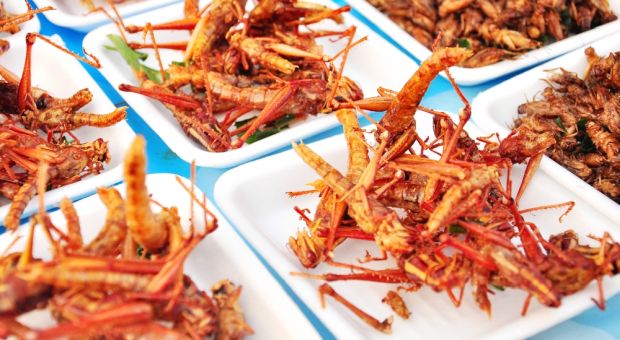Following “backlash” (just kidding) from our readers after one of my recent articles about eating bugs for survival, I’ve decided to dive deeper into the topic, as per one of our fans’ request.
Hence, today we’ll talk more about entomophagy, also known as insect eating.
To begin with, it’s a known historic fact that people used to eat various species of insects from prehistoric times. The practice is still alive and kicking today, in approximately 80 percent of world’s nations, i.e. most cultures in “the current year” are eating 1000 to 2000 species of insects on regular basis. So, one of our readers asked us to write more about insect farming, as in how much to feed them, costs of “production”, what species are tastier, as in best for survival, macronutrient ratio and all that geek stuff. Okay then, here it comes:
The Macronutrient Ratio
Eating insects for survival or out of passion is a rational thing to do, as insects are incredibly protein/nutrient rich compared to regular livestock. Also, they require less space/land to farm, as in they’re more resource-efficient with regard to producing calories/protein compared to farming animals, like cows, pigs or chickens. Also, even if it may sound strange to you, insects are “cleaner” than animals, as in they don’t carry as much diseases and pathogens that can affect us. On top of that, insect “meat” (just kidding, don’t throw rocks) is described by many aficionados as being incredibly tasty, even delicious, bursting with flavors and all that Skittles palaver. So, yes, insects can be best described as the “shrimp of the land”, at least according to some folks I know.
The truth is, insects are arthropodes, just like crab and lobsters, i.e. they’re in the same phylum, and we already consume trace amounts of bugs in our everyday food, and that’s the FDA’s opinion, not mine. And, in case you did not know it, there are already some restaurants in the US that serve bugs to their paying customers. No, I am not kidding, check this out.
As I’ve already told you, there are countless species of edible insects, but some of them are more popular than others when it comes to insect farming. My top-three edible insects consists of, in no particular order, crickets, grasshoppers and black soldier fly eggs. But the list of edible/farmable insects is as long as my arm.
The Farm 432 Project
It focuses on growing black soldier fly larvae. This particular type of insect has all the nutrients your body needs to function properly, i.e. 42 (!) percent protein and 32 percent fat, combined with various other stuff, like vitamins and minerals. Yes, the black soldier fly larvae are nothing short of a super-food.
After 432 hours [18 days], 1 gram of black soldier fly eggs turn into 2.4 kilograms of larvae protein, larvae that self-harvest and fall clean and ready to eat into a harvest bucket. Black soldier fly adults don´t eat, therefore they don´t have any mouth parts and do not transmit any disease. The larvae can be fed on bio waste, therefore the production almost costs no water or CO2. Black soldier fly larvae are one of the most efficient protein converters in insects…
And yes, pound for pound, nothing beats insects when it comes to getting edible protein/nutrients. This small scale setup will provide you with 3 meals per week, or 500 grams of bugs every seven days. If you want more, scale-up.
Now, there are always the “banal” grasshoppers. These critters contain 20.6 percent protein, along with 6 grams of fat and 4 grams of carbohydrates per 100 grams. Also known as locusts, grasshoppers are to be found basically anywhere, which makes them “proper halal” for survivalists, and their eggs take 2 to 3 weeks to hatch. Grasshopper food consists of plant material, like veggies and leaves and what not. Raising grasshoppers for food is pretty straight forward. All that’s required is a large and well ventilated box. As per specs, think along the lines of 20 x 20 x 10 inches for a dozen of grasshoppers, and you can go from there if you want to expand your operation. Again, scale-up.
The box must be filled with dry oatmeal, or dry sand, or coconut fiber, and to make it more friendly, you can put some twigs, branches and small rocks inside, as a habitat of sorts. The optimal temperature for grasshoppers to live long and prosper is between 77 and 95 F, and keep humidity low. Keep in mind that grasshoppers don’t require water per-se, but you should spray a little water over their food. And if you were wondering, you can get your first batch at your local pet store. And I am not kidding either. Also, they’re easy to find under rocks, inside seed pods, behind loose bark, in decaying stumps or on earth mounds. Keep in mind they’re easiest to pick at dawn, off grass stems, when they’re “comfortably numbed” by the drop in temperature.
Let’s Talk about Crickets, Shall We?
Crickets are also very easy to farm, and cricket-meat contains 13 percent protein, 5.5 percent fat and 5 percent carbs. You can use a 14 gallon container to hold up to five hundred of these bad boys, a bin of sorts for example, featuring a mesh top, for proper ventilation. Unlike grasshoppers, crickets require water. You can use silica based products, like Aquasorb, to provide your bugs with H20, i.e. products that absorb water inside, which can be later drink from by crickets. Or, you can go for watering pads, cotton balls, or even a wet sponge. The optimal “operating temperature” for crickets is around 86 F. The optimal habitat for crickets is very modest, all you have to do is to put some cardboard or paper egg cartons inside the “cage”. As per food, crickets love veggies. Keep in mind that crickets will require a tray filed with moist topsoil for breeding.
One female cricket lays about 100 eggs in her 4-month lifespan. Roughly half of these eggs will hatch female crickets, so you will have 50 more layers, each laying 100 eggs, or 5000 more crickets within the next few months. So, a minimal initial investment in a cricket colony could absolutely feed a family of four.
Moreover, here’s a cool video from CNN depicting a larger-scale bug-farming operation, the Big Cricket Farms respectively, America’s first edible cricket farm. Which means, it can be done, for survival or whatever.
With regard to how much to feed your edible bug of choice, well, since they thrive on food scraps basically, you’ll have to determine this on a case-by-case basis, depending on the “volume” of your bug colony. Keep in mind that crickets require protein in their diets, and if they don’t have enough protein, they’ll eat other crickets. Or die. Don’t worry, as you can find commercial bug-food at your pet store, or on the interwebz.
Costs of Production
Well, the costs are next to zero, provided you already have the container for your bug colony, or you can get it from somewhere free of charge. Bugs are thriving on almost nothing, really, provided they have a cozy shelter and enough food, i.e. your daily food scraps. If you’re not looking at industrial-scale bug-farming, the operating costs for your bug-food-supplements should be next to zero.
I hope the article helped. If you have other ideas, questions or comments, you know what to do. Have fun bugging, mkay?
You may also want to read






































































Might I suggest we all put at least 5% of out time our money and intelect towards insuring the Political Area is not allowed to deteriorate to the point such considerations need be part of the American Reality…
SP “intellect” lol
I really enjoyed the bug articles. I have eaten my share of bugs. Something else I have been interested in is birds other than the obvious. Chicken, turkey, dove, pigeon etc. You remember the song about blackbirds in a pie. The American Indians using bird points.( tiny arrowheads) So my question is What/which wild birds are edible.?.
The stats are impressive, but the usefulness of growing and harvesting bugs is if people actually want to eat them. The idea of eating fly larvae is repulsive to me, but I’m ignorant about the topic and open to learning more. I’m hoping to see a part 3 with recipes from the western world, not some tribe in the Amazon!